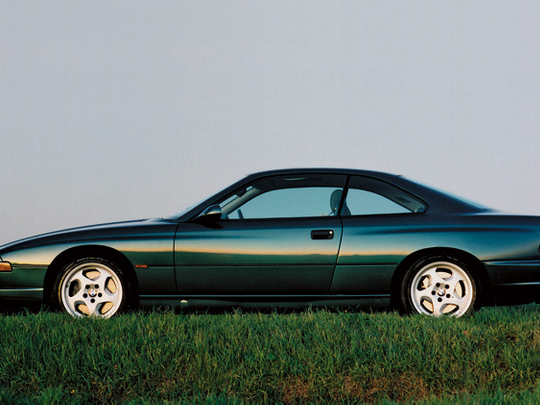
When BMW launched the 8 Series, the world cruelly dismissed it as too expensive, too heavy, too complicated, and not very good at being a sportscar anyway.
More for us, we say, because while much of those criticisms do hold true, the 8 Series was never meant to be a sportscar at any rate. It's a GT in the truest sense, and at the time it was the greatest GT on the planet.
The 6 Series was getting seriously long in the tooth in the late Eighties, and for the 1989 Frankfurt motor show, BMW whipped out the biggest number in its designation series yet. The 8 Series was to be based on a brand new coupé platform, instead of sharing bits and bobs with smaller cars like the 6 Series predecessor, and carry a price tag higher than even the ‘flagship' 7er.
To meet the growing dimensions, BMW stretched the car in all areas compared to the 6er, and draped the rear-wheel drive chassis completely in heavy steel, for want of a lighter composite material (this was the Eighties, remember). This made the freshly launched 850i tip the scales at 1.8-tonnes, which was gargantuan in the day, although BMW managed a 50:50 weight distribution despite nestling a gigantic V12 engine under that sloping bonnet.
Even if the choice of a V12 engine was meant to compensate for the weight, the 5.0-litre only produced just shy of 300 horses and 450Nm of torque, which was barely good enough for a seven-second run to 100kph, and a limited 250kph top end thanks to low drag and excellent aerodynamics. But a four-speed automatic transmission didn't really help the 850i's horrendous thirst for premium fuel.
So far, so bad, but there are plenty of reasons why this modern classic deserves your attention. BMW crammed the 8 Series full of ground-breaking new technology for a production car, such as speed-sensitive power steering, seat-integrated safety belts, and BMW's first-ever electronic stability control system.
Many cars also came with the optional electronically controlled dampers, which automatically adjusted to road conditions much like many of today's luxury cars do.
Inside, the 8 Series broke from BMW tradition with a more adventurous dash design, but Munich surprised few when it fitted the 850i with every extra under the sun, such as a standard car phone, 12-speakerCD player, heated seats with a memory function and on-board computer — not the kind of stuff you usually bring up when talking about classics.
Yet many turned away from the fabulous 850i due to the extremely complicatedV12 engine and those same hi-tech interior and exterior goodies that made the car so desirable to curious early-Nineties buyers in the first place.
Even a midlife power hike to 322bhp in the 850Ci couldn't really save the fate of the V12 GT, which is why the V8-engined 840i ‘baby' 8 Series is where the smart man's money is. Both the 850i and the 840i can be had for as little as 10 grand in the UAE, but also climb up to 60 grand and above in tandem. This is because when it comes to the 8 Series, condition matters much more than trim and the badge on the back.
Numerous reputable BMW specialists in Dubai can also ensure that your 8 Series remains in good hands, but do a complete check — regardless of whether you're risking it with a 850i or taking the sensible route with the 840i — before cash changes hands.
Find a cared-for car, and the ‘notorious' electronics shouldn't cause much concern. The same goes for the misunderstood V12, which we'd stay away from simply because of its lack of power and greed for fuel. In fact, the V12 is bulletproof specifically because it's so unstressed, but the biggest problem is simple maintenance, which isn't very simple when the head needs to come off for even the smallest jobs.
The 4.0-litre V8, which at 282bhp makes nearly as much power as the early V12s, is common and so are its spare parts. Try to stay away from early ones with Nikasil cylinder linings, and you're looking at nothing more than regular servicing.
No, the engines and electronics — as opposed to popular opinion — really aren't the problem here. Instead, that would be the automatic transmission, which does and will fail regularly. If you're looking at a high-miler, make sure it's been completely replaced, and if your eye is on a mint low-mileage car, keep in mind that you'll need to set aside up to15 grand for a tranny replacement once you get to about 100,000km.
But seeing as the most expensive low-mileage, late-model 8 Series on the localused-car market is only 46 grand, you can't really complain about maintenance costs of a king-of-the-road BMW Grand Tourer for that money.











